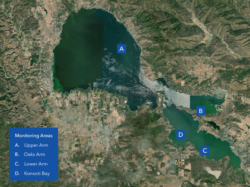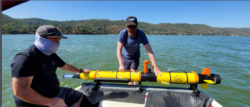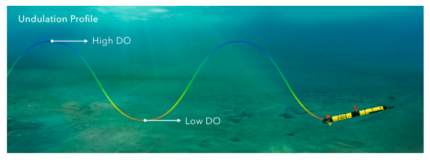from YSI/Xylem
 This summary is drawn from Xylem’s whitepaper on this topic; to read the full report you can download the pdf here.
This summary is drawn from Xylem’s whitepaper on this topic; to read the full report you can download the pdf here.
As we know, Harmful Algal Blooms (HABs) are one of greatest global threats to surface water quality, harming drinking water sources, wildlife habitat, recreational opportunities and waters of special significance to indigenous people. The impacts of HABs can range from nuisance taste and odors to production of powerful toxins that can sicken animals and people.
Excessive nutrient loading, especially with nitrogen and phosphorus, can lead to HABs. Adding in warmer water temperatures (as from climate change) and water column stratification boosts cyanobacteria growth.
To understand bloom dynamics and production of toxins, scientists have to figure out a complex array of hydrological and meteorological factors. Autonomous underwater vehicles (AUV’s) with multiple sensors, like YSI’s i3XO EcoMapper, can be part of the solution – as demonstrated in a recent study of HABs in Clear Lake, California.
Clear Lake is one of the oldest natural lakes in North American, and is heavily impacted by HABs. The lake’s increasingly eutrophic state is due at least in part to years of open pit mining, heavy use of pesticides, and significant construction/landscape alteration that have led to watershed erosion. This has spurred the growth of cyanobacteria and the toxins it can produce, especially during summer months, when recreational use of the lake is at its peak.
While the general conditions promoting blooms are well understood, it has been harder to determine the details of the environmental factors driving the growth of specific cyanobacteria.
With funding from the California Central Valley Regional Water Quality Control Board, scientists from the University of Southern California, Southern California Coastal Water Research Project, and YSI met at Clear Lake. They deployed the EcoMapper and other tools to find out more about Clear Lake and cyanobacteria.
Gathering data at Clear Lake
The challenge was to link water column structure and environmental parameters with information on plankton from individual water samples. The study monitored the lake along its three “arms” to determine lake-wide characteristics and mapped part of the lake’s Konocti Bay at high resolution to look closely at the distribution of cyanobacteria at a smaller scale.
Data collected by the EcoMapper, including missions along the arms of the lake where the vehicle was programmed to undulate (dive and rise through the water), were used to construct 2D depictions and planar views of the water column in each arm.
The mapping of Konocti Bay was intended to document its varied and changing features to help groups decide where and how to collect and interpret samples from the embayment where cyanobacterial scums regularly accumulate.
Conclusion
The i3XO EcoMapper provided excellent data at both the ‘whole lake’ scale and in high resolution at Konocti Bay. Subsequent missions are planned to expand on the data already collected to further dissect the spatial and temporal relationships between water quality and algal blooms. The instrument will improve understanding of water column structure and heterogeneity in Clear Lake. The EcoMapper’s spatial coverage, multiple sensors, small size and ease of deployment can be of great help to anyone studying HABs or water quality in general.

An undulation pattern enables one to profile water quality parameters such as Dissolved Oxygen in this representation. DO at any point travelled by the vehicle can be identified.
For more information, read the entire white paper at https://www.ysi.com/file%20library/documents/white%20papers/high-resolution-mapping-of-a-harmful-algal-bloom.pdf
Or contact YSI, a Xylem brand, at YSI.com or info@ysi.com


